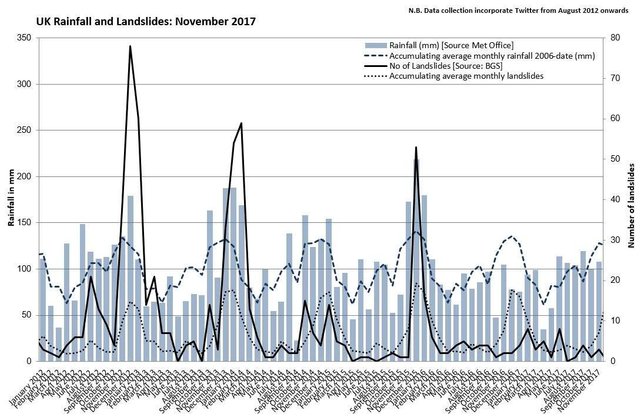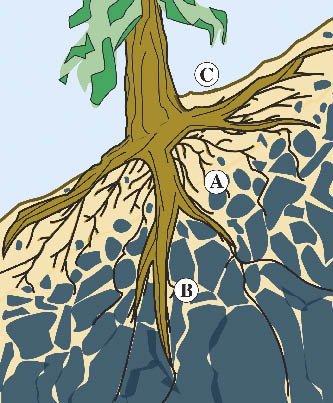What are landslides and why do they often occur during heavy rainfall?
We hear a lot about landslides in the news when after a period of heavy rainfall a landslide occurred and caused heavy damage to infrastructure or even take lives. It is not a coincidence that these events always occur during a storm or a period of heavy rainfall. To explain this link I will shortly explain landslides.
What are landslides
First of all, there are many types of landslides. A landslide is literally defined as an event where earth or rocks are moved without the main carrier being water or air. If the main carrier is water or air we would speak about erosion and not about a landslide. The main classes of landslides are shown in the illustration below.
Each landslide type is dependent on the soil material (or lack thereof), water content and hill slope. The landslide types that are most influenced by water content, and thus heavy rains, are landslides where the soil slides rather than bare rocks.
Safety factor
to asses the risk of a landslide a safety factor is introduced. The idea is fairly easy, you add up all the factors that keep soil on the hill (cohesion, root strength, friction etc.) and you divide that by all the factors that want to move the soil (mainly gravity). When this safety factor is far above 1, there is no risk. When the factor approaches 1 the hill becomes unstable and when the factor drops below 1, you should not have a hill slope anymore. This factor fluctuates in time and can be visualized.
What causes landslides
Type of material
Soils on hills behave in many different ways and each type of rock has its own physical properties such as permeability, cohesion, stratification, shear strength etc. This makes the composition of the bedrock and soil one of the key factors in predicting landslides. Different rocks also lead to different soil forming processes, and different types of soil are more susceptible for landslides.
Water
When there is a storm or a period of heavy rainfall there is a lot of water that infiltrates the soil. This extra water increases the unit weight of the soil and makes it heavy. Gravity will pull more on the soil then it would when it was dry and the risk of landslides increases.
Another way water induces landslides is by increasing the pore pressure. This can be seen as the uplifting of the soil by high pressured groundwater, or a buoyancy force lifting up the soil. This effect reduces the friction that used to keep the soil from sliding and thus increases the risk of landslides.
In addition to these effects, water can dissolve and erode materials that "glue" the soil together such as various minerals. This permanent removal of cohesive materials again weakens the soil cohesion.
We clearly see in the next graph that water plays a major role in the occurrence of landslides.

The terrain
Besides the weakening effect of water, the slope gradient is an important factor. Gravity will have a more significant influence on the stability of a hillside when the slope is steep. Also it is possible that the terrain converges water to some points. These points will be saturated by water faster and the risk of a landslide is locally increased due to the reasons mentioned in the part about water.
Vegetation
Rich vegetation on a slope stabilizes the soil. The roots of the plants add strength to a hillside and increase the deep infiltration of water during storms. Vegetation furthermore cause transpiration which dries the ground more rapid after a storm. Clear cutting this vegetation may cause instabilities due to the loss of root strength, loss of drainage channels and decreased transpiration.

How to prevent landslides
Now that we have seen what causes landslides, what can we do to prevent them? As many hills have been converted from forest and wild vegetation to fields for agriculture, A lot of the soil strength has been lost due to this conversion and restoring this natural vegetation may be a solution to stabilize these hills again. But because this implies a stop of agricultural activities in the area it is often not an option. It can be an option to replant trees or shrubs on parts that are not used, such as parcel borders.
A second way to reduce landslides is to increase drainage of the soil. By draining water from the soil, pore pressure is reduced and soils maintain their stability. But by draining the water you increase the risk of gully erosion.
A final way to reduce the risk of a landslide is by removing soil mass from the top. This reduces the stress caused by gravity.
Sources
Source 1 World landslide forum
Source 2 Advancing Culture of Living with Landslides
Source 3 Landslide Science and Practice
Source 4 Landslide risk assessment in a densely populated hilly area
excellent post I love, greetings I follow you when you want to go through my profile. Thank you.
super post .. i follow you and i support you 🤗
support me if you want too ♥️
@OriginalWorks
The @OriginalWorks bot has determined this post by @samve to be original material and upvoted(1.5%) it!
To call @OriginalWorks, simply reply to any post with @originalworks or !originalworks in your message!
Congratulations @samve! You have completed some achievement on Steemit and have been rewarded with new badge(s) :
Click on any badge to view your own Board of Honor on SteemitBoard.
For more information about SteemitBoard, click here
If you no longer want to receive notifications, reply to this comment with the word
STOPCongratulations @samve, this post is the most rewarded post (based on pending payouts) in the last 12 hours written by a Dust account holder (accounts that hold between 0 and 0.01 Mega Vests). The total number of posts by Dust account holders during this period was 5807 and the total pending payments to posts in this category was $782.39. To see the full list of highest paid posts across all accounts categories, click here.
If you do not wish to receive these messages in future, please reply stop to this comment.